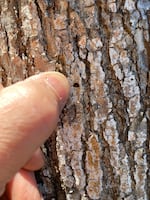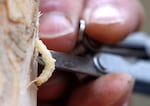A couple of weeks ago, Dominic Maze was picking up his kids from summer camp at a school parking lot in Forest Grove.
He got there early. Rather than distracting himself with his cellphone, Maze got out of the car and began to examine a nearby stand of ash trees. He noticed green shoots coming up from the trees’ bases. They looked “haggard,” he said.
“And then I got just a terrible sinking feeling in my stomach that I might be looking at emerald ash borer infestation,” said Maze, who works as an invasive species biologist for the city of Portland.
The emerald ash borer was first detected in the United States in 2002, outside Detroit, Michigan. The beetles have since killed hundreds of millions of ash trees, mostly in the Midwest and on the East Coast.

A D-shaped exit hole indicates an emerald ash borer infestation on an ash tree in Forest Grove, Ore.
Dominic Maze / Courtesy
Emerald ash borer larvae basically eat a tree from the inside out, munching on inner bark and restricting the plant’s ability to transport nutrients and water until the tree dies. They emerge from ash trees as metallic green beetles, leaving D-shaped pockmarks behind.
Maze walked up to the trees and saw the alphabetical exit holes, he said, “and then I knew.” He had been waiting for these bugs, and they were finally here. It was the first detection of emerald ash borer west of Boulder, Colorado.
The effects on land, water and wildlife in Oregon could be devastating.
“Emerald ash borer, as it’s done to other North American ash species on the eastern seaboard, is expected to basically wipe out up to 99% if not more Oregon ash on the landscape,” Maze said.
Oregon ash is one of 16 North American ash species and the only one native to the Pacific Northwest. The trees are most prevalent in the Willamette Valley west of the Cascades and along the Columbia River.

In an undated photo provided by the Minnesota Department of Natural Resources, an adult emerald ash borer is shown. The highly destructive insects which kill ash trees are metallic green and about 1/2-inch long.
Minnesota Department of Natural Resources / AP
Maze said Oregon ash trees are perhaps the most important species for riverbank stabilization and shade for Willamette River tributaries. Losing those trees would likely lead to increased stream temperatures and an accompanying decline in water quality.
Contrary to many deciduous forests in the Midwest and on the East Coast, Maze said, Oregon doesn’t have many tree species that can replace ash in the event of a mass die-off.
While ash species have built up chemical defenses to native insects, they cannot stop the emerald ash borer, which is indigenous to China, Japan and other Asian nations.
“The reason why this insect, in particular, is so problematic is it’s never been successfully eradicated,” said Christine Buhl, an entomologist with the Oregon Department of Forestry. “Due to its biology and the way it spreads, it’s been shown to be virtually impossible to eradicate.”
So far, the state has not confirmed any established colonies of emerald ash borer outside of the Forest Grove stand.
Slowing the spread
The late arrival of the beetles, about 20 years after they were first detected in the U.S., has allowed Oregon to plan ahead.
Some municipalities like Portland have prohibited planting ash as street trees, for example. The state has also harvested and stored close to a million Oregon ash seeds to try to preserve the species’ genetic diversity for replanting.

In this Oct. 26, 2011 file photo, an emerald ash borer larvae is removed from an ash tree in Saugerties, N.Y. The emerald ash borer, first found in 2002 in Michigan, is now in 30 states and has killed hundreds of millions of ash trees. Forests from New England to the West Coast are jeopardized by invasive pests that defoliate and kill trees. Scientists said the pests are driving some tree species toward extinction and causing billions of dollars a year in damage.
Mike Groll / AP
Buhl said slowing the spread of emerald ash borer is the only tool the state has to possibly save pockets of Oregon ash.
“Slowing the spread just buys us time,” Buhl said. “We don’t have time to preemptively remove all the ash and replace them with other trees. We need time for action and slowing the spread is essential for that.”
She said first Oregonians need to be able to identify an ash tree and then understand the signs of possible infestation. D-shaped exit holes, basal shoots, dead treetops and S-shaped patterns under the bark from where larvae feed are some visible symptoms. The shiny green adults are also prevalent on infected trees in summer.
People who think they’ve identified an emerald ash borer infestation can report it to the Oregon Invasive Species Council hotline online or by calling 1-866-INVADER. Know what emerald ash borers look like before reporting, Buhl said, because there are many similar-looking insects.
The state also recommends people avoid transporting firewood, which can carry emerald ash borers and larvae from place to place.
